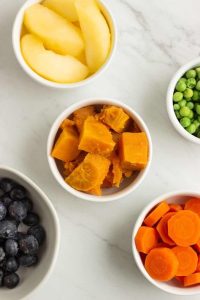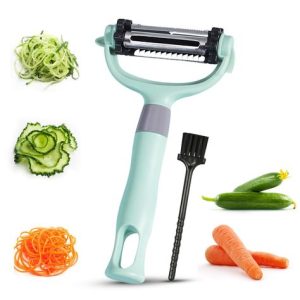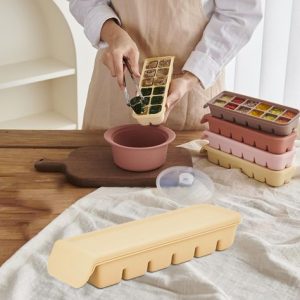Types of vegetable puree are a fantastic way to introduce new flavors and textures to babies, but they’re also a delicious and versatile ingredient for people of all ages! They’re easy to digest, packed with nutrients, and can in countless ways. This article will explore the wonderful world of vegetable purees, from classic favorites to exciting new flavor combinations.
The Benefits of Purees
There are many reasons to love vegetable purees! Here are a few:
Packed with Nutrients:
Vegetables are a great source of vitamins, minerals, and fiber. Pureeing them concentrates these nutrients, making them readily available for your body.
Easy to Digest:
Purees are smooth and easy to swallow, making them ideal for babies just starting solids or people with digestive issues.
Flavorful and Versatile:
Purees can be made from a wide variety of vegetables, offering endless flavor possibilities. They can be enjoyed on their own, used as dips or sauces, or incorporated into other dishes.

Classic and Delicious Purees
Let’s start with some popular and easy-to-make vegetable purees:
- Sweet Potato Puree: This classic is naturally sweet and loved by babies and adults alike. Simply roast or steam sweet potatoes, then puree until smooth. You can add a little cinnamon or nutmeg for extra flavor.
- Carrot Puree: Another naturally sweet option, carrot puree is a great source of beta-carotene. Roast or steam carrots until tender, then puree.
- Butternut Squash Puree: Butternut squash has a slightly nutty flavor and a creamy texture. Roast or steam butternut squash cubes until soft, then puree.
Branching Out with Flavor Combinations
Once you’ve mastered the classics, why not experiment with some exciting flavor combinations? Here are a few ideas:
- Green Pea and Mint Puree: This refreshing puree combines the sweetness of peas with the coolness of mint. Steam or blanch green peas, then puree with a little fresh mint.
- Beet and Apple Puree: This vibrant puree offers a sweet and earthy flavor combination. Roast or steam beets until tender, then puree with a peeled and chopped apple.
- Roasted Cauliflower and Parmesan Puree: Roasting cauliflower brings out its nutty flavor. Roast cauliflower florets, then puree with grated Parmesan cheese.

Tips for Making Perfect Purees
Here are some helpful tips for making delicious and nutritious vegetable purees:
- Choose Ripe Vegetables: Ripe vegetables will have the best flavor and texture.
- Cooking Methods: Steaming or roasting are great ways to cook vegetables for purees. These methods preserve nutrients and create a smooth texture.
- Adding Liquids: A little water, broth, or breastmilk can be added to achieve the desired consistency.
- Seasoning: Don’t be afraid to experiment with different herbs and spices to add extra flavor. Start with a small amount and taste as you go.
Creative Uses for Purees
Vegetable purees are incredibly versatile! Here are a few ideas for incorporating them into your meals:
- Baby Food: Purees are a perfect first food for babies. They can be enjoyed on their own or mixed with other ingredients like yogurt or cereal.
- Soups and Sauces: Purees can be thinned with broth or milk to create creamy soups or flavorful sauces.
- Dips and Spreads: Purees can be thickened with mashed beans or tahini to create delicious dips and spreads.
- Baked Goods: Purees can be added to breads, muffins, and pancakes for extra moisture and flavor.
Vegetable purees are a nutritious, delicious, and versatile addition to any diet. With a little creativity, you can enjoy the goodness of vegetables in countless ways. So, grab your favorite veggies and start exploring the world of purees!

Expanding Your Puree Palate
Beyond the classics and flavorful combinations, there’s a whole world of types of vegetable puree
to explore! Here are some ideas to pique your curiosity:
- Roasted Corn and Poblano Puree: This vibrant puree offers a sweet and smoky flavor combination. Roast corn kernels and poblano pepper chunks, then puree with a bit of lime juice and cilantro.
- Broccoli and Leek Puree: This creamy puree is packed with vitamins and minerals. Steam broccoli florets and leeks until tender, then puree with a little grated cheese.
- Roasted Eggplant and Bell Pepper Puree: Roasting eggplant brings out its rich, smoky flavor. Roast eggplant cubes and bell pepper strips, then puree with a touch of olive oil and garlic.
Types of Vegetable Puree for Every Season
The beauty of vegetable purees is that they can be adapted to seasonal ingredients. Here are some ideas for incorporating seasonal vegetables:
- Summer: Zucchini, summer squash, asparagus, fresh peas
- Fall: Butternut squash, pumpkin, sweet potato, Brussels sprouts
- Winter: Beets, parsnips, turnips, kale
- Spring: Artichokes, green peas, sugar snap peas, fresh herbs
Global Types of Vegetable Puree Inspiration
Looking for even more inspiration? Vegetable purees are a staple in many cultures around the world. Here are a few ideas to spark your creativity:
- Indian-Spiced Carrot Puree: Roast carrots with cumin, coriander, and turmeric for a warm and flavorful puree.
- Japanese Sweet Potato and Ginger Puree: This puree is a delicious accompaniment to grilled fish or tofu. Steam or roast sweet potatoes with a knob of ginger, then puree with a drizzle of soy sauce.
- Mexican Butternut Squash and Poblano Puree: This smoky and slightly spicy puree is perfect for tacos or burritos. Roast butternut squash and poblano pepper with chipotle chili powder, then puree with a bit of lime juice.
With so many possibilities, vegetable purees are a delicious and versatile way to explore the world of healthy eating. So experiment, have fun, and enjoy the pure goodness of vegetables!
Types of Vegetable Puree for Different Dietary Needs
Vegetable purees can be a great option for people with various dietary needs. Here are some ideas:
- Vegan Purees: Many classic and seasonal purees are naturally vegan. Opt for vegetable broths or coconut milk to add moisture or creaminess.
- Low-Carb Purees: Focus on non-starchy vegetables like broccoli, cauliflower, and leafy greens.
- Gluten-Free Purees: All vegetable purees are naturally gluten-free!

Sneak in Extra Veggies with Veggie Purees
Purees are a fantastic way to add extra vegetables to your diet, especially for picky eaters or those who struggle to meet their daily veggie intake. Here are some sneaky ways to incorporate purees:
- Mix purees into pasta sauce for a hidden veggie boost.
- Add pureed cauliflower or zucchini to mashed potatoes for extra creaminess and nutrients.
- Fold pureed spinach or kale into scrambled eggs.
- Freeze leftover purees in ice cube trays and add them to smoothies for a veggie punch.

